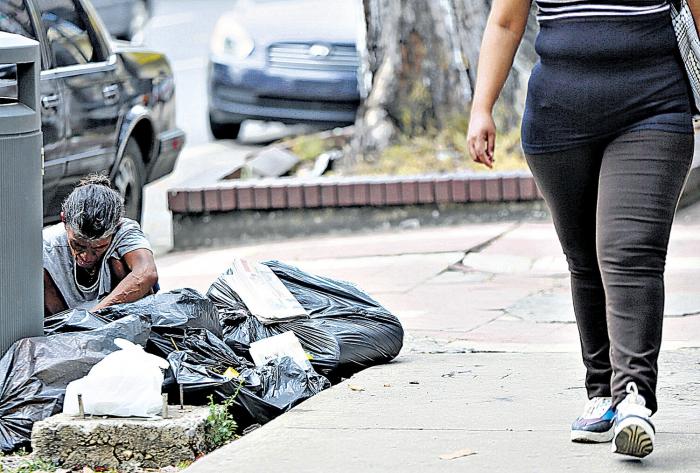Much like the US, homeless and poverty is visible and needs to be dealt with.
- By : James Bryson
- Category : Human Interest

Panama has presented a growth like no region in Latin America (15% per year) according to World Bank statistics. However, despite this indicator, Panamanian wealth has remained in macroeconomic numbers and in very few hands. This makes it the third most unequal country in Latin America, also known as the least equal region on the planet.
According to the ‘Annual Report on Poverty and Extreme Poverty in Panama’, issued by the Panama Without Poverty Initiative and updated in November 2022, 1 in 4 Panamanians is poor. Today, the general poverty rate in Panama, after Covid-19, is estimated at 25.0%, which affects 1.1 million Panamanians.
Today, the wealthiest population, which represents 10% of the total, obtains 37.3% of the national income, almost 13 times more than the poorest 40%. In addition, as in almost the entire world, the statistics affect the Afro-descendant, women and rural population more. In the comarcas, for example, 90% of its inhabitants live in poverty. A reality accompanies a persistent inequality, related to the strong territorial imbalances that exist in the country; This is how the Inter-American Development Bank (IDB) details it, for which, Panama is a geographically small country, with a territorial occupation of 75,517 square km and a population of 4.3 million inhabitants, the country presents its highest level of inequality in capital city.
According to a note published this year in the Spanish newspaper, El País, 80% of the Gross Domestic Product (GDP) is concentrated in two cities in the interoceanic zone; it comes from the Canal itself and from a handful of related activities, such as free zones, the financial sector, and construction.

What is poverty?
According to the Economic Commission for Latin America and the Caribbean (ECLAC), “extreme poverty” or “indigence” is defined as the situation in which resources are not available to satisfy at least basic food needs. In addition, “total poverty” is defined as the situation in which income is less than the value of a basic basket of goods and services, that is, food and non-food goods.
Due to world inflation, Panama’s basic basket increased to an amount of $270.00 until May 2022. Bloomberg positions Panama’s food basket as the third most expensive in Latin America after Guatemala ($285.60), and Venezuela ($381.00). leaving Honduras ($269.00) in fourth place on the list.
Under this idea, a more real vision of what the Panamanian population lives to assume the high costs of food is created, taking into account the minimum wage of $290.00 to $315.00 that they receive monthly.
To this must be added in the same way, 9.9% of the unemployed population and 48.21% that is in informality due to the economic crisis that the Covid-19 pandemic left until April of this year according to data of the National Institute of Statistics and Census (INEC).
Poverty Levels and Extreme Poverty 2022
The average annual decrease is -0.1 percentage points. This indicates that by 2030, the total reduction would reach a level of 24.5%, affecting more than 1.2 million Panamanians.
On the other hand, 1 out of every 10 Panamanians is indigent or lives in extreme poverty. This year, this rate in Panama is estimated at 10.6%, affecting more than 464 thousand Panamanians. The average annual reduction is -0.03 percentage points, which by 2030 projects a reduction that would reach a level of 10.3%, affecting more than 500,000 Panamanians.
Inequality in the canal country
For the IDB, Panama is positioned as the third country with the greatest inequality in Latin America according to its GDP per capita.
On average in 2013/17, the capital province, the richest in the country, has received 28% more investment per capita than the average. On the other hand, the Ngöbe Buglé region, with barely 26% per capita income compared to the national average, has received 70% less investment per inhabitant.
What do Fitch and Moody’s say?
Some of the most important risk rating agencies in the world have released their reports issued in October by Fitch Ratings (10.4.2022) and Moody’s (10.25.2022). In said reports, they maintained the Investment Grade of the Panamanian sovereign debt where Fitch maintained its perspective as “Stable” while Moody’s lowered its perspective from “Stable” to “Negative”.
Fitch supports its “Stable” rating by maintaining the Panamanian sovereign debt that it granted in its Report presented on January 28 of this year after the new agreement between the Government and Minera Panama was announced on the 16th of the same month. With this, he credited the Panama Canal and mining exports as the main reasons for his upgrade in rating by two points: GDP growth in 2021 and the strength of the fiscal situation.
On the other hand, Moody’s pointed out that growth prospects are favorable for the next two years, being driven by the reopening of the economy from the pandemic, the increase in mining production, and investment in infrastructure. This projects an average real GDP growth of 4.4% over the 2023-2025 period.
However, Moody’s maintained its change from “Stable” Outlook to “Negative” with the reduction of the deficit necessary to meet the goals of the Fiscal Responsibility Law, which will be increasingly complicated due to the high pressures of public spending and the greater probability that the central government needs to provide financial support to the Social Security Fund (CSS) due to the growing deficit of the defined benefit program is destined to consume its reserves.
Both firms agree with the fact that the support for the CSS’s Disability, Old Age and Death Program (IVM) presents a greater indebtedness and risk for the Panamanian Government. According to Moody’s, the deterioration of the CSS’s financial position will become another source of spending pressures.



No Comments